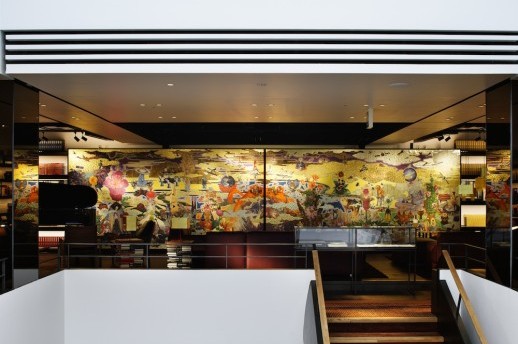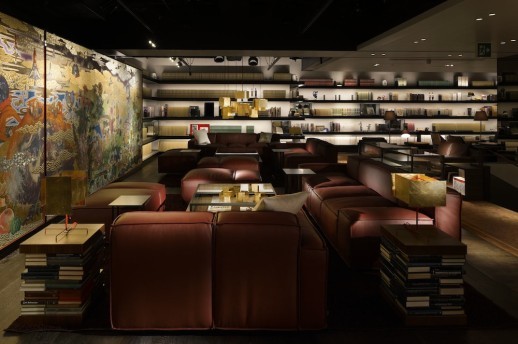Public Art #2: Masatake Kouzaki’s Tougen, Anjin

Strictly speaking, public art is often considered art displayed in public, and paid for by the public. In a city like Tokyo, most art displayed in public is in fact privately funded (such as through the public art law in which all new Tokyo developments must include art in the project’s total cost), and its role as a public artwork is subject to the wishes of its owners. Nonetheless, without too much concern over definitions, Tokyo has plenty of art that the public can enjoy for free. Sometimes public art can be found inside.
Bookshops are marvelous places. They inspire imagination, adventure and awe, but rarely do the books themselves become a footnote to what is hung on the walls. At the top of a staircase at Tsutaya Books’ (T-Site’s) shop in Daikanyama is a painting that manages to do just that. From the base of the stairs it’s possible to see a glimmer of something golden before you, but when you reach the uppermost stair; your field of vision is consumed by gilded splendour. And it’s warped.
Masatake Kouzaki’s Tougen, Anjin (2011) fits snugly into the surroundings of the Anjin Lounge, a café found inside the second level of building number two. Occupying every inch it was commissioned for, the result of this work in a public space isn’t exactly understated. At about nine metres wide and over two metres tall, it consists of two screens of folded panels. It’s both a diptych and a set of byōbu (folded screens); it’s something of a hybrid form, borrowing from both East and West. But its vast scale and the abundant use of gold foil ensures that it dazzles viewers into taking a closer look, and this is where it surprises.
From afar, it’s a detailed and decorative work that appears classical, even scholarly. With cloud drifts trailing across its surface, it teases a glimpse at an isolated land like the works of the Yamoto-e , where partially obscured narratives lie beneath cloud cover It’s a symmetrical piece and is composed around a constellation of planets that echo Hieronymus Bosch’s sixteenth century painting, The Garden of Earthly Delights. Also like Bosch’s central panel, its vivid imagery is densely populated among lakes and lagoons, flora and fauna. Unlike Earthly Delights, it isn’t teeming with lustful figures in orgy, but depicts a land inhabited by curious hybrid creatures, collaged together in strange collisions of cut and paste.
Leopard-headed dinosaurs, winged stags and guinea pigs with the legs of giraffes are among the numerous beings on land, while all around is visually engineered vegetation blooming and brimming with life. Kouzaki’s application of gold foil is expansive and varied. Sometimes the surface is textured with stars or bubbled patterns; at other times hieroglyphs, five-leafed clovers and hexagonal grids. Despite its imposing scale, Tougen, Anjin retains a sense of playfulness that can be found close up. The shapes that the clouds reveal are often pool-like, either describing coastlines or horizons or blending the two. Galleons and gondolas swim in the sky while a distant Earth submerges into a ground of gas. Made from a texture of references, Kouzaki includes man-made inventions too. Horned squids fly through the sky next to orbiting satellites; astronauts explore volcanic spas beneath fleets of space shuttles venturing beyond the heavens. All in all, it’s a fantastical vision.
Taking its title, Tougen, from the early Chinese fable, “Peach Blossom Land”, this is Kouzaki’s on-going project to depict a secluded utopia where people and the natural world co-exist harmoniously, oblivious to the outside world. While one of the prominent figures in Kouzaki’s painting, a nude woman sitting cross-legged with a globe as a head, suggests this insular universe, the overall content of the painting seems to resemble less of a paradise than it does a science fiction parable about genetic meddling.

Speaking at a recent talk at a Pecha-Kucha event, Kouzaki acknowledged his debt to the traditions of Nihonga and Bosch’s work, as well as being influenced by Japanese TV shows that mixed animals together to create monstrous villains. But before these creatures are found in Tougen, Anjin, the opulence of the gold seems to act like a Venus fly trap, ambushing the viewer into discovering this astonishing tribute to inventiveness. “I wanted to display a primordial soup – a mixing of all things,” in the artist’s own words.
And after all that gorgeous art, it’s easy to forget the book you went there for.
Tougen, Anjin is found at 17-5 Sarugakucho, Shibuya, or at these coordinates: 35.649176, 139.699321
Nick West
Nick West


